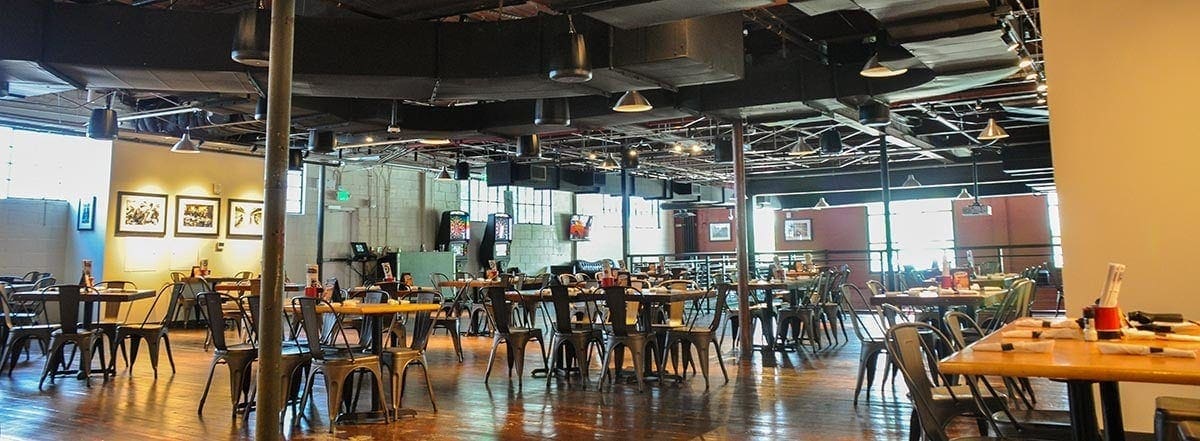A great dining experience is also about how the space feels, not just about having great food selections. Music or sound plays a big role in that. If your audio is too loud, too soft or cutting in and out, it can throw everything off.
The right restaurant sound system helps create a certain atmosphere, smooth out awkward silences and keep people comfortable without needing to raise their voices.
This article gives you a practical breakdown from the AV install side: what really works, what doesn’t and how we at Crunchy Tech design sound that blends in seamlessly, whether it’s for a cozy café, a full-service restaurant or a venue with outdoor seating.
Why Restaurant Audio Demands a Different Approach
Before you pick speakers or plug anything in, it’s critical to understand why restaurants require a different audio approach altogether.
Even if you’ve set up a great sound system at home, applying that same mindset to a restaurant is a costly mistake. Commercial audio design has a lot more to do with controlling the sound in order to complement the environment.
A restaurant’s layout, materials, hours of operation and customer flow all factor into what kind of system you need.
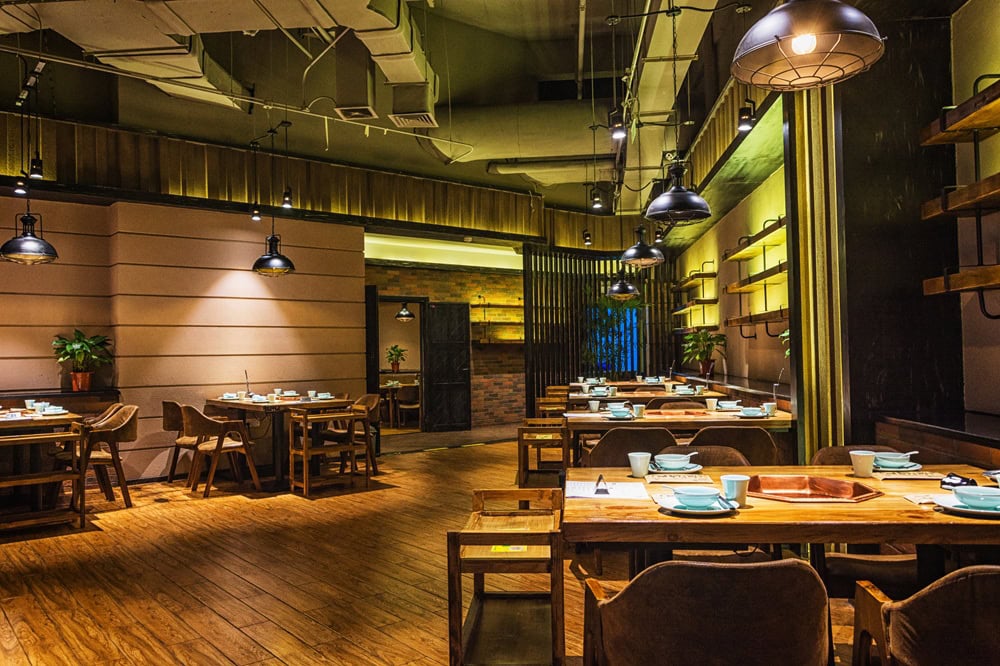
Restaurants have complicated acoustics
Hard surfaces, open ceilings and noisy kitchens all compete with your sound system.
Restaurants are filled with reflective materials: tile, glass, concrete, stainless steel. That’s a recipe for echo and sound bounce. Add to that the constant clatter of plates, background chatter, blenders and espresso machines and your music is suddenly fighting for airspace.
At home, you might have carpets and curtains that naturally soften the sound. In a restaurant, it’s all sharp edges and ambient noise.
Restaurant audio runs long hours and needs to stay consistent
You’re not just playing music for ambiance. You’re doing it for 10+ hours a day, 7 days a week.
Most consumer-grade speakers aren’t built for that kind of duty cycle. They get hot, distort or eventually fail. Restaurant audio systems need to run for extended periods without breaking a sweat. That means commercial-grade amplifiers, tuned speaker loads and ideally, in-ceiling speaker setups that dissipate heat and stay out of the way.
For example, a restaurant owner used home-theater equipment for his business. It works fine for a couple months, then the issues start: dropouts, volume irregularities or blown drivers.
PRO TIP: Always spec for endurance, not just sound quality.
Music zones matter more than volume
Restaurants are rarely just one open room. You’ve got bar seating, booths, outdoor patios, restrooms, sometimes even a private dining area. Each of those zones deserves its own volume control and, in some cases, even its own audio source. What works in the main room might feel overwhelming in a quiet corner.
Zoning is therefore a necessity. And it doesn’t need to be complicated. With the right matrix or amplifier setup, you can control zones from a wall-mounted knob or a tablet. It makes your entire system more adaptable and stops your staff from constantly fiddling with one master volume slider that never makes everyone happy.
Understanding Your Restaurant’s Audio Needs
Not all restaurants need the same equipment but they all need a plan. The biggest issues we see come from owners who buy gear before understanding how their layout, materials and service flow affect sound. The right system isn’t the one with the most watts. It’s the one that’s tailored to your space, staff and guests.
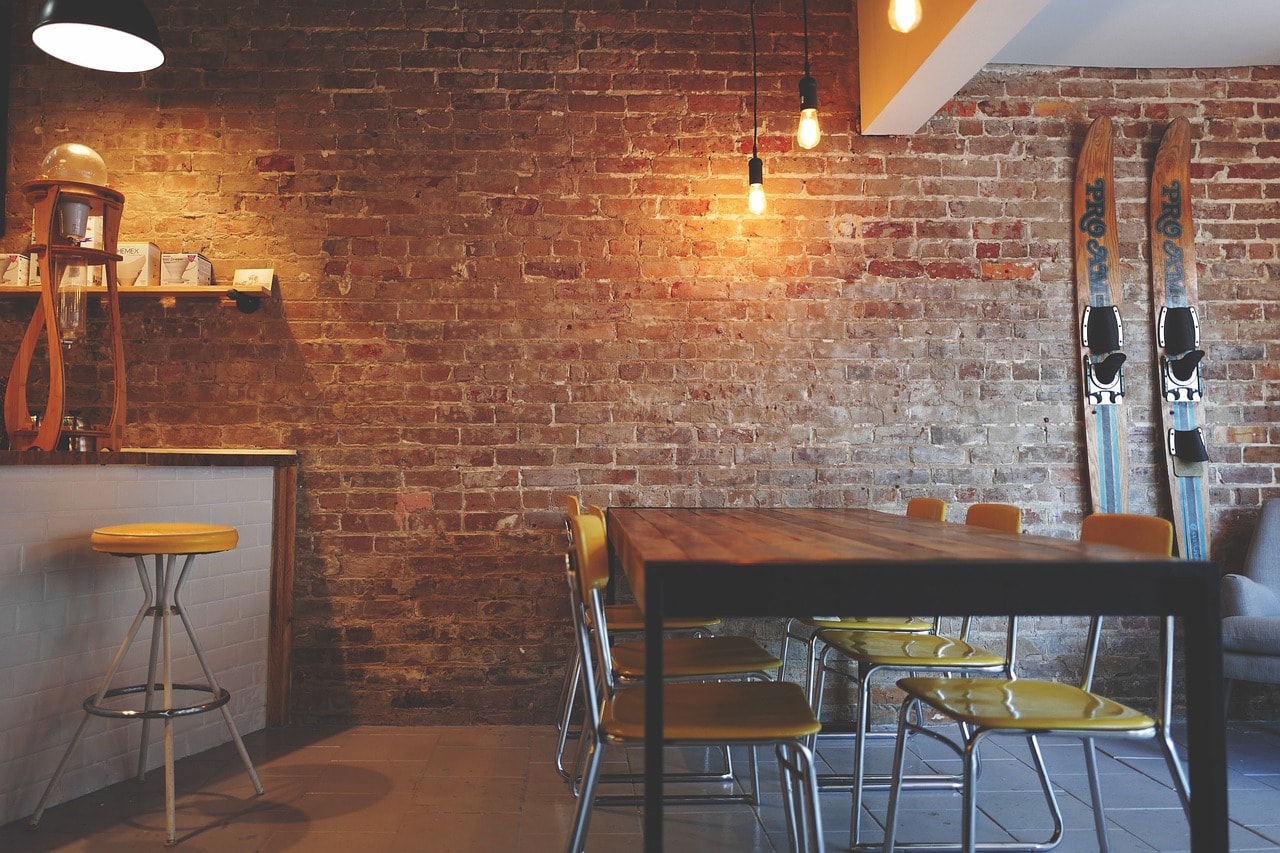
Square footage isn’t everything
A 1,500 sq ft open loft needs a different setup than a 1,500 sq ft series of dining nooks.
People throw four big box-store speakers into an oddly shaped space and wonder why it sounds like a gym. Large open rooms with high ceilings need more evenly spaced in-ceiling speakers to distribute sound without hotspots or dead zones.
On the other hand, long narrow rooms benefit from directional coverage that pushes sound down the length of the space instead of bouncing it off walls.
And don’t overlook ceiling height. A 14-foot ceiling with pendant lights and HVAC ducts is going to scatter audio differently than a flat 8-foot ceiling. That changes the angle and spacing of in-ceiling speakers, most notably if we’re trying to control sound bleed into quiet zones.
Seating layout determines speaker placement
Always map sound around where people sit and not just where walls are. Booths up against drywall reflect more bass. High-top tables in open areas might need tighter sound cones to avoid spill. Our rule of thumb: never blast audio directly at a table.
Instead, create an ambient sound field (felt, not forced) so guests can carry a conversation without shouting or asking for the music to be turned down.
We walk through the space and mark out where people are eating, waiting and gathering. That informs the number and positioning of in-ceiling speakers, subwoofers if needed and zone controls.
Consider what’s competing with the music
Restaurants aren’t quiet. Sound masking isn’t exclusive to offices. If your kitchen opens into the dining area or your bar has constant ice-machine churn, you’ll need controlled coverage that fills the room without needing to overpower the space.
This is where directional in-ceiling speakers and low-frequency support make a difference. We often recommend adding subtle bass reinforcement to balance out harsh mids from metal surfaces or glass panels.
Zoning, Coverage and Volume Control: Designing Sound That Fits the Room
If your restaurant has more than one room or even just distinct seating areas, you need a sound system that lets you control each part of the space independently.
We don’t mean giving your bar manager a remote to crank the volume. We’re talking about creating zones: different parts of the restaurant with their own speakers, volume levels and sometimes even music feeds.
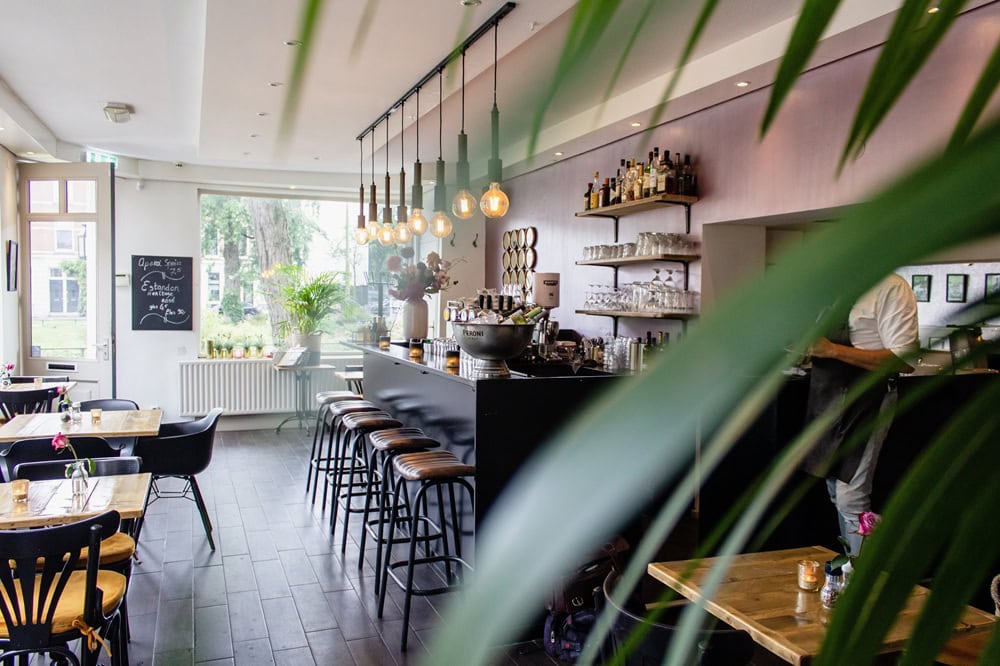
What Is Zoning?
A zone is a group of speakers controlled as a unit but built with purpose.
In a small café, you might just need two: one for the dining area, one for the patio. In a larger restaurant, you’ll probably need to break things up further: main dining, bar, private room, bathroom, kitchen and outdoor.
Each zone gets its own volume level. That way, you’re not blasting the bar just to hear music in the restroom or drowning out diners near the kitchen with the same feed used on the patio. You’ll notice fewer customer complaints and a better dining experience when the sound feels intentional.
How We Set Up Zones at Crunchy Tech
We start with a zone layout map: we sketch your floorplan, then walk through and mark out how customers move, where staff gather and what the natural breakpoints are in your space. Then we spec gear that allows volume control for each of those areas.
Most of the time, this means using a DSP (digital signal processor) or matrix amp with zone outputs. Each zone runs through its own speaker line and volume channel. In some installs, we’ll add physical wall-mounted knobs that are simple, labeled and tamper-proof. In others, especially more modern venues, we give you app-based control via a tablet or mobile device.
What matters is this: once it’s set up, you don’t need to think about it again. It just works and it works exactly the way your team needs it to during a busy Friday night.
What About Outdoor Zones?
Many systems treat the patio like it’s just an extension of the dining room. But outdoor audio is competing with ambient noise (e.g., cars, birds, wind, crowds). It needs its own gain structure and EQ curve. If you run the same signal outside and inside without controls, you’ll either underpower the patio or overwhelm the indoor guests.
If you separate patio zones, that gives your staff the flexibility to turn it up during happy hour, lower it during brunch or shut it off entirely on rainy days.
Don’t Forget Bathrooms and Transitional Spaces
Quiet zones shouldn’t be silent and they shouldn’t echo.
Bathrooms, hallways and vestibules are often forgotten during audio planning. But silence in these spaces can feel awkward and a single poorly placed speaker can make them sound like a tunnel. You can use low-output in-ceiling speakers here with soft volume, often tied to their own sub-zone, so you get consistent ambiance without overkill.
This kind of detail doesn’t show up in spec sheets. It shows up in how customers feel when they walk through your space.
Best Sound System for Restaurants
There’s no shortage of speaker brands claiming to offer “restaurant-quality” sound. But after years of working in dining spaces, from Orlando food halls to high-end hotel bars, we’ve seen what holds up under daily use and what doesn’t. Below are the brands we recommend based on real-world installs.
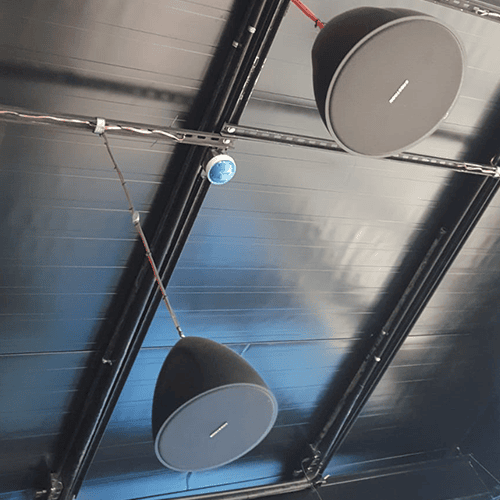
Bose Professional
Great for: In-ceiling installs, clean aesthetic venues and scalable audio coverage
Bose doesn’t just make headphones. Their DesignMax and FreeSpace lines are built for commercial use: clean, powerful and unobtrusive. We use their in-ceiling models often in venues that want evenly dispersed, full-range sound without visible clutter. Their speakers blend into white ceilings, don’t require deep mounting clearance and sound good right out of the box.
Why we like it:
- Consistent tonal quality across speaker sizes
- Compatible with 70V distributed systems for multi-zone setups
- Weather-resistant models available for patio installs
- Smart pairing with Bose amps keeps the system unified
Crunchy Tip: If you’re running a space with high ceilings and lots of reflective surfaces, the directional models in the DesignMax series help aim sound right where it needs to go without bouncing it off tile or glass.
QSC (Q-SYS & AcousticDesign Series)
Best for scalable restaurant systems and multi‑zone control with user-friendly operation
QSC’s Q‑SYS platform combines commercial amplifiers, DSP, zone mixers, and in-ceiling or surface-mount speakers into one unified system. Their AcousticDesign series delivers rich, balanced sound with low-profile aesthetics across multiple zones.
Why we use it:
- Built-in app and remote control for front-of-house staff
- Flexible 70 V line support and multi-channel routing
- Consistent performance in both small cafés and larger themed venues
Biamp (Tesira & Vocia)
Ideal for background music combined with paging and brand-aligned ambiance
Biamp is designed with hospitality in mind. Their Tesira and Vocia platforms provide mixing amplifiers, low-profile MASKC or NIKO speakers, and integrated paging/announcements all controlled via intuitive GUIs.
Crunchy advantage:
- High speech clarity without sacrificing music tone
- Aesthetic forethought: speakers blend into venue design
- Clean UI that restaurant staff actually can use
Crestron (DM‑NAX Audio‑over‑IP Ecosystem)
Perfect for high-tech venues or multi-location restaurants needing IP audio control
Crestron’s DM‑NAX delivers scalable, ultra-low latency audio over Dante or AES67 networks, using PoE-edge devices that eliminate bulky cabling or external amps.
Where it shines:
- Seamless integration with lighting, HVAC, displays and AV control
- Remote troubleshooting and zone management
- Designed for venues with precise automation needs
Extron
Smart choice for clean, integrated installs with flexible signal distribution
Extron specializes in networked audio distribution, DSP, and control hardware that plays well with existing AV systems and Crestron-type automation setups. They also offer in-ceiling speakers and amps designed for commercial use.
Why integrators choose it:
- Reliable audio transport via Dante over standard network cabling
- Tight integration with touchscreen control panels
- Built for clean, serviceable installations in modern restaurants
JBL Professional
Trusted for rugged, proven performance across restaurant and hotel installs
JBL’s Control Contractor and PSB soundbar lines have been a go-to for hospitality installs. They offer a range of in-ceiling, surface-mount and outdoor speakers that consistently deliver vocal clarity and musical richness.
Trusted picks:
- JBL Control 26CT ceiling speakers that are easy to daisy-chain and spec for cooling and long-term operation
- Low profiles blend easily into décor and perform well in high-ceiling zones
Electro‑Voice (EV EVID Series)
Extremely reliable solutions for foreground, background, indoor or outdoor audio
Electro‑Voice’s EVID line covers ceiling, wall, pendant and surface mount formats with weather‑rated models available. It gives coverage and clarity even in harsh environments.
Best for:
- Multi-style installations with matching aesthetic finishes
- Reliable performance under constant usage
- Indoor/outdoor flexibility; IP‑rated models available for patios
Atlona
Essential for signal switching, control, and integration with audio/AV systems
Atlona excels at AV distribution—HDMI, audio, IR, and control signals—across complex retail, bar, or restaurant environments that demand synchronized content and audio switching.
Integration wins:
- Enhances system reliability when bundled into larger AV deployments
- Clean switching between audio sources (e.g. music, announcements, video feeds)
- Volume control wall plates or remote-triggered muting
Restaurant Speaker Placement Done Right
Where you place the speaker matters just as much as what speaker you buy. Even great speakers will sound bad if they’re mounted in the wrong spot. We’ve seen it: clustered too close together, stuck in corners, aimed at glass or spaced too far apart.
When we design a restaurant audio system, we build it like lighting. We layer it, we distribute it and we aim for full, even coverage without calling attention to the source. How we get it right:

Start With the Tables
You’re designing for where people sit.
Begin with the furniture layout. Speaker placement revolves around customer position. That means speakers shouldn’t hover directly over a table or aim sound directly at someone’s head. You want overlap zones that blend smoothly between speakers to create a soft wash of sound throughout the space.
In-ceiling speakers work best when they’re centered above aisles or aligned between tables and not over them. We space them based on cone angle and ceiling height, usually 6 to 10 feet apart depending on wattage and dispersion.
Avoid Hotspots, Dead Zones and Echo Chambers
If someone’s yelling over music at table 12 while it’s dead silent at table 5, you’ve got a coverage problem. That usually comes from either:
- Installing too few speakers and cranking them too high
- Installing too many speakers too close together
- Mounting speakers near reflective surfaces (glass, tile, mirrors)
We use layout software to simulate SPL (sound pressure level) across the room before we ever drill a hole. That lets us balance coverage, minimize reflections and reduce noise hotspots. We’re not guessing. We’re engineering it quietly.
Why In-Ceiling Speakers Are Our Go-To
In-ceiling speakers free up wall space, hide clutter and create clean, consistent sound across rooms. They’re especially effective in restaurants with modern or minimalist aesthetics. When paired with a 70V system, we can scale easily, adding more speakers later without having to redesign the whole system.
We spec models with wide dispersion angles and sealed backs to control bleed between floors. For higher ceilings, we sometimes use pendant-mount versions to drop the speaker closer to ear height.
CRUNCHY TIP: Always use tile bridge kits or mounting brackets for commercial ceilings. Otherwise, over time the weight of the speaker can warp the ceiling tile or worse, fall.
Outdoor Speaker Placement Isn’t Only ‘Point and Play’
Outdoors, you’re dealing with wind, traffic, hardscape bounce and open air. Speakers should be angled downward, aimed inward and spaced evenly along the perimeter, not just stuck near the entryway.
We recommend mounting them 7–10 feet off the ground, tilted toward the center of the patio space. For larger areas, we can use multiple pairs with directional cones to avoid blasting one corner while the rest of the space hears next to nothing.
And yes, always use outdoor-rated hardware. That means IP-rated enclosures, rustproof brackets and proper drainage spacing. Otherwise, summer rains will take them out faster than a spilled margarita.
Bathrooms, Hallways and Entry Zones Also Need Attention
These are the zones people forget, but they shape guest perception. Bathrooms with dead silence or harsh echo kill atmosphere. We can use low-wattage in-ceiling speakers tuned to a softer output, often paired with the bar or dining zone feed but isolated on volume.
Hallways and vestibules should serve as acoustic transitions rather than zones of silence or sudden jumps in volume. Smooth audio flow keeps your space feeling cohesive from entry to exit.
Crunchy Tech Placement Philosophy
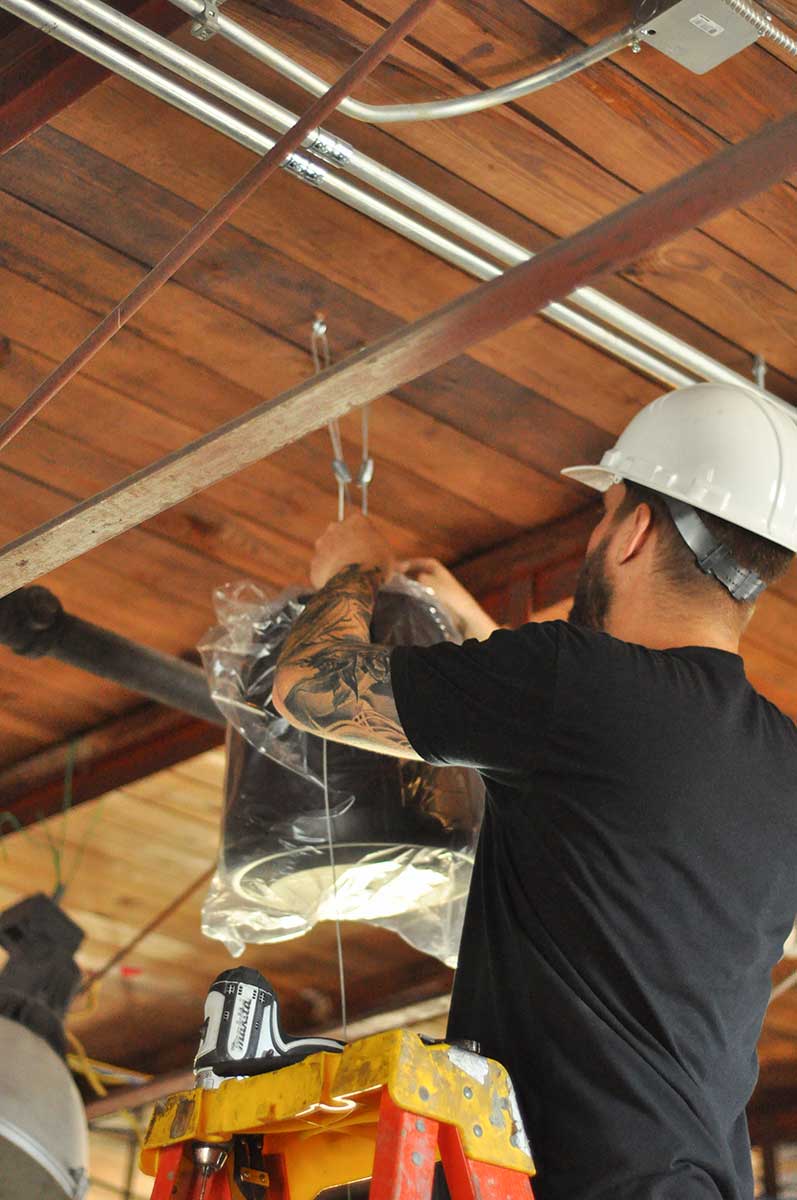
Every speaker we mount, we mount with intent. We aim for invisibility, evenness and no volume battles. And we always build with growth in mind: ceiling placement that accommodates expansion, bracket types that allow pivoting and conduit routing that’s serviceable.
That’s how you future-proof your commercial audio system and make it part of the space, not a noisy distraction from it.
Outdoor and Patio Sound Systems
Outdoor dining is one of the biggest opportunities for restaurants, but sonically, it’s also the most overlooked.
We’ve installed sound systems on rooftop lounges, poolside patios, open-air cafes and downtown terraces. The common thread is most outdoor systems we replace weren’t built to last or were treated like an afterthought.
Apart from volume, patio audio should take into account direction, durability and day-to-night flexibility. Wherever you are in the United States, climate throws everything at your gear – sun, salt, moisture, storms. If your speakers aren’t built for that, you’ll be replacing them every year.
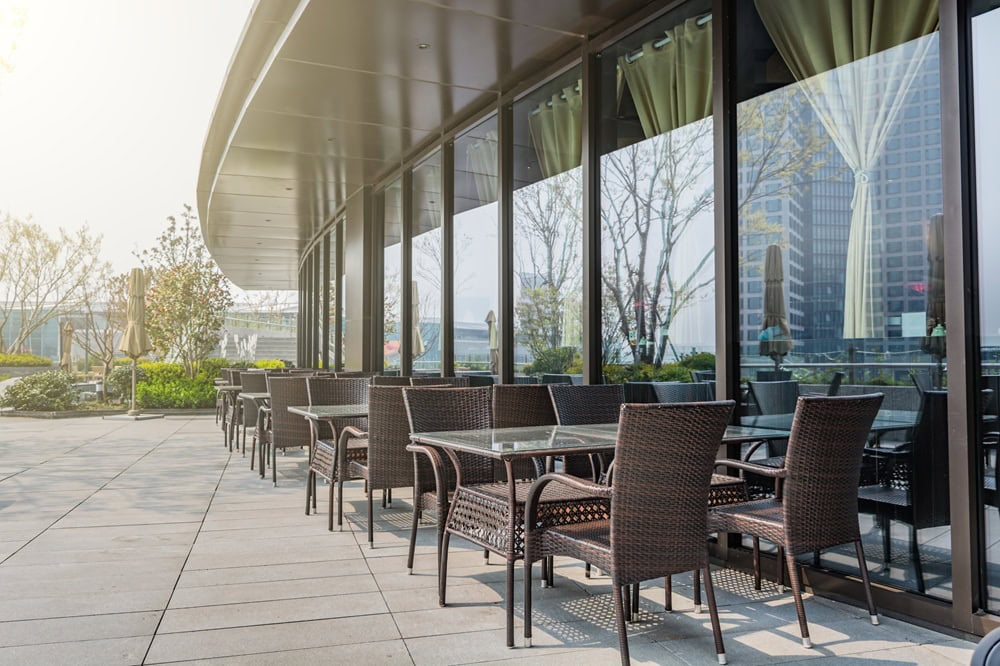
Use Weatherproof Speakers
If your outdoor speakers aren’t IP-rated, they don’t belong outside.
We don’t install “indoor/outdoor” speakers with vague labels. We use fully weatherized, commercial-grade models with proper IP ratings (typically IP55 or higher). That means:
- Water-resistant seals
- UV-stable enclosures
- Corrosion-proof brackets
- Drip-safe construction
We also avoid anything with paper cones or exposed ports. Your gear should shed rain, not trap it.
Mounting Height and Angle Make or Break It
Here you want directional control. If your speakers are mounted flat and high, sound will dissipate before it reaches the audience. If they’re too low or pointed at hard surfaces, you’ll get echoes or muddiness.
On wide patios, we recommend spaced pairs; left/right coverage zones about every 15–20 feet depending on speaker output. For large spaces, we might zone each half of the patio independently so the bar side can stay louder during happy hour while the dining section remains relaxed.
Don’t Share Indoor and Outdoor Zones
They might play the same playlist, but they need different control.
One of the biggest mistakes we see is a single volume knob controlling both the dining room and the patio. It seems efficient. But outdoor environments require higher SPLs to compensate for wind, traffic and open air.
That means if you’re matching volume across both zones, someone’s getting blasted or someone can’t hear anything at all. And when needed, we can install directional speakers or low-profile landscape models that blend into the architecture while keeping the sound focused.
Power and Signal Cabling for Outdoor Zones
If the cable can’t survive the elements, your speakers won’t either.
AV integrators use buried conduit, UV-rated cabling and weather-sealed boxes on every patio or outdoor zone install. For areas with no attic access or retrofits, they route through lighting conduit or column channels when possible, never exposed zip ties or surface cable staples. If you’re investing in commercial gear, protect it with infrastructure built to match.
We also recommend surge protection and line conditioning. Florida storms aren’t gentle. One power spike during a thunderstorm can toast an entire amp rack or melt an outdoor volume controller.
How We Design Outdoor Systems at Crunchy Tech
It’s not about loud. It’s about immersive. We never just bolt two speakers to the wall. We model the zone using SPL tools, simulate daytime and evening conditions and build the system to flex:
- Brighter, louder energy during weekend brunch or events
- Softer, directional wash during evening dining
- Optional off-switch for bad weather or quiet hours
We tune every outdoor zone at peak time with real ambient noise, not just an empty space. If your patio sounds great at 2 p.m. but terrible when the bar is full and traffic is humming, it wasn’t tuned right.
Common Mistakes We See as AV Integrators
There’s a lot that can go wrong with restaurant sound. Most of it happens before the first song even plays. Wrong speakers, bad cabling, poor zoning or a well-meaning but overmatched DIY setup, we’ve seen it.
Here are the most frequent mistakes we come across and why we design every Crunchy Tech system to avoid them from the very beginning.
Using Consumer Speakers in a Commercial Setting
If it was built for a living room, it won’t survive a lunch rush. Home speakers can’t handle long hours, variable power loads or large, open-air environments. They break down, they distort and they absolutely can’t be scaled when your layout changes or grows.
Our rule is simple: if it’s not rated for commercial use, we don’t install it. That includes speakers, amps and even control panels. There’s no “close enough” in this game.
Cranking Volume to Compensate for Bad Layout
Too few speakers = too much volume.
When a restaurant installs three speakers where there should be eight, what happens? Staff turns the volume up to fill the space, which creates hotspots (too loud) and dead zones (can’t hear a thing). It stresses the amp, shortens speaker life and frustrates guests who can’t talk over dinner.
We always design for coverage, not loudness. That means more speakers, lower individual volume and a smooth blanket of sound rather than a few blaring sources.
Skipping Zoning or Grouping Too Much Together
You can’t treat a dining room and a patio the same way.
If your entire restaurant plays from a single audio source with one volume control, you’re giving up flexibility before you even open. A good sound system should let you adjust volume by section or mute individual zones when not in use.
One of the first things we check in any consultation is: How many zones do you actually need?
- Dining room
- Bar
- Patio
- Bathrooms
- Kitchen
- Private event space
You don’t always need separate content, but you always need separate control.
Going All-In on Wireless Without a Safety Net
Wireless speakers may sound convenient, but when the Wi-Fi drops or the network gets crowded or a speaker loses signal in the middle of a Saturday night dinner rush, you’re basically stuck. We’ve replaced entire systems that were less than a year old because the wireless gear just couldn’t keep up.
Use hardwired systems when you can. And if you absolutely must go wireless, plan a fallback: wired signal paths, preloaded content and IT support on standby.
Underestimating Acoustics (Or Ignoring Them Altogether)
A hard-tile space with glass walls and metal furniture is going to sound sharp and echo-ey no matter how good your speakers are, unless you treat it. We’ve walked into gorgeous venues with incredible gear that still sounded like a warehouse because no one addressed the acoustic profile.
Our team listens to the room. Sometimes we’ll recommend acoustic panels, soft furnishings or ceiling baffles. Sometimes it’s just speaker aiming and EQ tuning. Either way, you can’t fix a noisy room by turning the music up.
Ignoring Maintenance and Long-Term Support
A sound system is only as good as its upkeep. Even the best sound system for restaurants needs occasional checks. Dust, cable wear, surge damage and environmental exposure (especially on patios) can degrade performance over time.
And if no one on your staff knows how to troubleshoot, you’re one glitch away from silence. Whether it’s with us or another restaurant sound system integrator, don’t install and forget. Build a maintenance plan into your AV budget.
Best Restaurant Sound System FAQs
How to budget for a restaurant sound system
A good rule of thumb is to allocate between $3 and $8 per square foot for a professionally installed system. This includes in-ceiling or outdoor speakers, amplifiers, zoning equipment, cabling, labor and tuning.
Factors such as high ceilings, multiple zones (bar, patio, restrooms), or live audio capabilities may push your cost toward the higher end of that range. If you’re running a smaller café or quick-serve space, your budget can be leaner but don’t skimp on reliable hardware.
How to connect a laptop to a restaurant sound system
Most restaurant sound systems accept audio from a laptop using a simple connection: either a 3.5mm to RCA adapter, 3.5mm to XLR or a USB audio interface if you want more control. For systems that support it, Bluetooth receivers can offer a wireless option, but they’re not ideal for long-term reliability.
In a pro setup, we can route laptops through a mixer or digital signal processor to avoid spikes in volume or degraded sound quality.
How to install a restaurant sound system
Installing a restaurant sound system starts with careful planning. You need to map out zones – dining area, kitchen, bar, outdoor patio – then determine how many speakers each zone needs based on ceiling height and room acoustics. Wiring is run through the ceiling or conduit to connect all speakers to a centralized amplifier with DSP capabilities.
Finally, speakers are mounted (in-ceiling, surface-mount, or pendant) and tuned for volume and EQ consistency. For multi-zone systems, wall-mounted or app-based controls are typically installed. Hiring a licensed AV integrator ensures safety and code compliance for large or public spaces.
How to outfit a commercial sound system for your restaurant
A commercial sound system should match the flow and size of your restaurant, not just blast music evenly across all spaces. Start with the right speakers; in-ceiling or pendant models for indoor dining and weather-resistant speakers for patios.
Then select a commercial-grade amplifier with DSP and zoning abilities. Add a control interface for staff to adjust volume and source by zone. Lastly, power the system with a licensed streaming music source to stay compliant with performance rights.
How to set up a restaurant PA sound system
A public address (PA) system is essential if you plan to make announcements, call out orders or host live events. Begin with a mixer or amplifier that supports microphone inputs, then combine it with paging microphones placed near the host stand or bar.
The speakers should be positioned strategically so your announcements can be heard clearly without disrupting diners. Many modern PA systems allow automatic ducking, which lowers the background music volume when someone speaks.
How to set up a restaurant portable sound system
Portable sound systems are ideal for pop-up events, food trucks or temporary setups. These systems typically consist of battery-powered Bluetooth speakers with mic inputs. Just place the unit in a central location, pair your device and you’re live.
Brands like JBL, Bose and Electro-Voice make reliable portable systems, but remember: they’re not meant to replace a full-zone installation. Use them as temporary solutions or for private event rooms.
How to set up the best sound system in a restaurant
The best systems are those your guests don’t notice. They just feel the ambiance is right. Begin with zoning: separate areas like bar, dining room, restrooms and patio each need independent volume control.
Use in-ceiling or pendant speakers with wide dispersion patterns for even coverage. Pair everything with a commercial amplifier that includes a DSP for sound balancing. Add a reliable control system, whether app-based or wall-mounted. And stream from a commercial music service that won’t break licensing laws.
How to set up a restaurant music sound system
Restaurant music systems begin with sourcing: pick a streaming service designed for businesses (like CloudCover Music or Soundtrack Your Brand). Connect that to a DSP-enabled amplifier and run speaker wire out to your ceiling speakers or wall-mounted units.
From there, use your DSP to tune EQ and volume per zone. Set schedules or playlists to match your restaurant’s vibe by daypart (lunch, dinner, weekend brunch, etc).
How to wire a sound system for a restaurant
Wiring a sound system properly means choosing the right cable and routing it safely. Use CL3 or plenum-rated speaker wire (usually 14 or 16 gauge), and make sure to keep runs under 200 feet to avoid signal loss. Route wires away from power lines to prevent interference, and use conduit when required by building codes.
Label each cable at both ends. It’ll save you hours during troubleshooting. If you’re running a 70V system, daisy-chain the wiring and set the tap wattage per speaker according to the zone’s needs.
How to wire a JBL restaurant sound system
Wiring JBL speakers for a restaurant depends on whether you’re using a low-impedance system (8-ohm) or a 70V distributed system. For most commercial installs, the 70V route is cleaner. Each JBL speaker (like the Control series) includes a tap switch to assign wattage. Set each one according to how loud you want it to be, then daisy-chain the wiring to the next speaker.
Make sure the total wattage of your speakers doesn’t exceed your amplifier’s output and always match polarity to avoid phase issues. JBL works well with Crown or Harman Professional amps and the pairing is rock solid.
Your Restaurant Deserves better Sound
Great sound doesn’t call attention to itself. It just works. It fills the room without overwhelming it. It supports the mood instead of dictating it. And when it’s executed correctly, your guests stay longer, spend more and come back.
The Crunchy Tech team spent years getting this right for restaurants across the country, from local spots with a few tables to multi-room venues. We design with precision, we install with care and we build systems that hold up night after night.
If you’re ready to stop fighting with volume knobs and start building an experience your guests feel, let’s go ahead and make your sound system your silent advantage.
